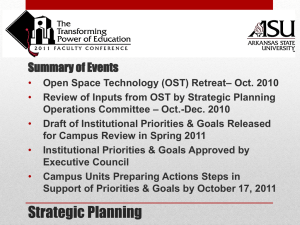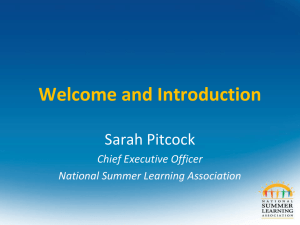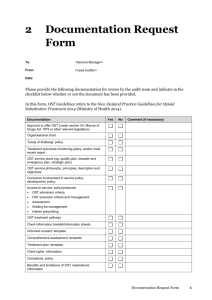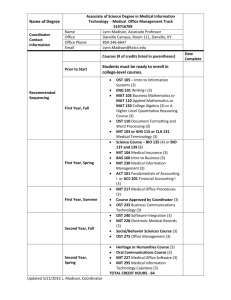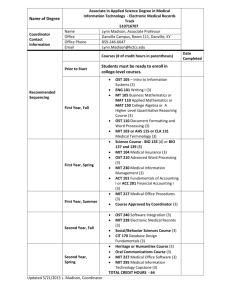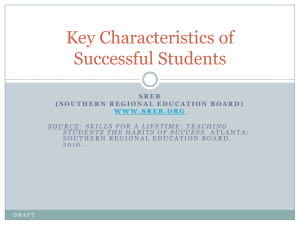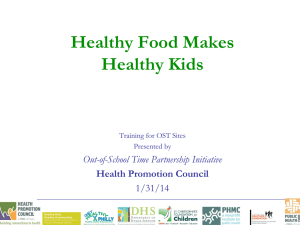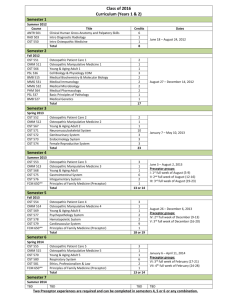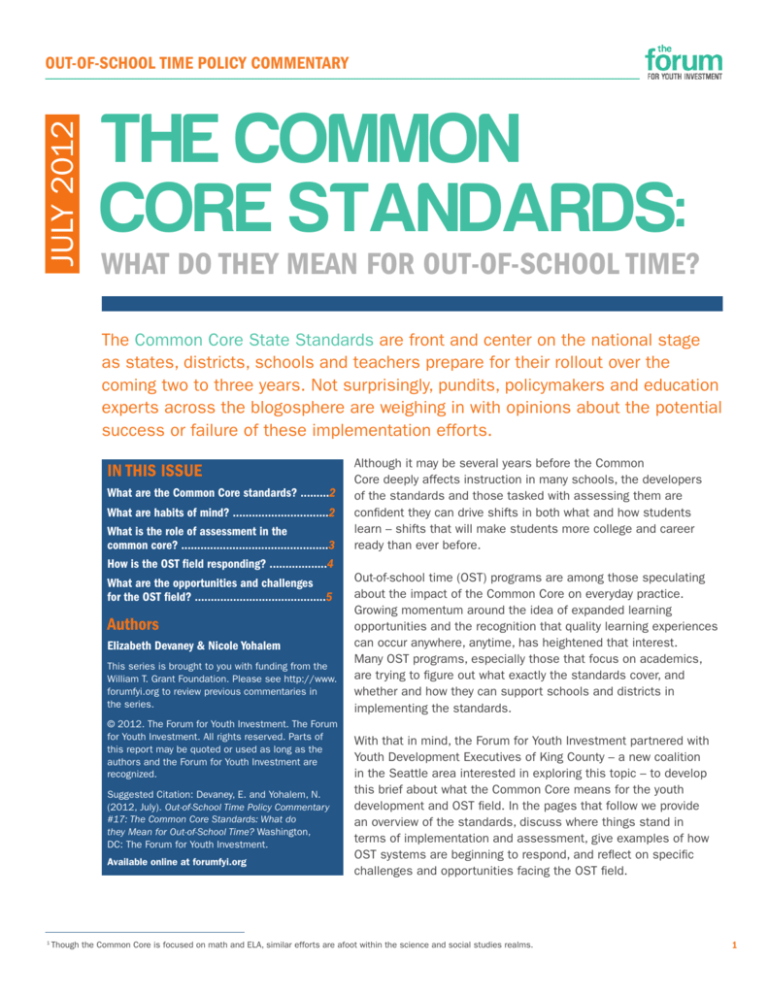
JULY 2012
OUT-OF-SCHOOL TIME POLICY COMMENTARY
THE COMMON
CORE STANDARDS:
WHAT DO THEY MEAN FOR OUT-OF-SCHOOL TIME?
The Common Core State Standards are front and center on the national stage
as states, districts, schools and teachers prepare for their rollout over the
coming two to three years. Not surprisingly, pundits, policymakers and education
experts across the blogosphere are weighing in with opinions about the potential
success or failure of these implementation efforts.
IN THIS ISSUE
What are the Common Core standards? .........2
What are habits of mind? ..............................2
What is the role of assessment in the
common core? ..............................................3
How is the OST field responding? ..................4
What are the opportunities and challenges
for the OST field? .........................................5
Authors
Elizabeth Devaney & Nicole Yohalem
This series is brought to you with funding from the
William T. Grant Foundation. Please see http://www.
forumfyi.org to review previous commentaries in
the series.
© 2012. The Forum for Youth Investment. The Forum
for Youth Investment. All rights reserved. Parts of
this report may be quoted or used as long as the
authors and the Forum for Youth Investment are
recognized.
Suggested Citation: Devaney, E. and Yohalem, N.
(2012, July). Out-of-School Time Policy Commentary
#17: The Common Core Standards: What do
they Mean for Out-of-School Time? Washington,
DC: The Forum for Youth Investment.
Available online at forumfyi.org
1
Although it may be several years before the Common
Core deeply affects instruction in many schools, the developers
of the standards and those tasked with assessing them are
confident they can drive shifts in both what and how students
learn – shifts that will make students more college and career
ready than ever before.
Out-of-school time (OST) programs are among those speculating
about the impact of the Common Core on everyday practice.
Growing momentum around the idea of expanded learning
opportunities and the recognition that quality learning experiences
can occur anywhere, anytime, has heightened that interest.
Many OST programs, especially those that focus on academics,
are trying to figure out what exactly the standards cover, and
whether and how they can support schools and districts in
implementing the standards.
With that in mind, the Forum for Youth Investment partnered with
Youth Development Executives of King County – a new coalition
in the Seattle area interested in exploring this topic – to develop
this brief about what the Common Core means for the youth
development and OST field. In the pages that follow we provide
an overview of the standards, discuss where things stand in
terms of implementation and assessment, give examples of how
OST systems are beginning to respond, and reflect on specific
challenges and opportunities facing the OST field.
Though the Common Core is focused on math and ELA, similar efforts are afoot within the science and social studies realms.
1
OUT-OF-SCHOOL TIME POLICY COMMENTARY
WHAT ARE THE COMMON CORE
STATE STANDARDS?
The Common Core is the result of a two-year process,
facilitated by the National Governor’s Association and the
Council of Chief State School Officers (CCSSO), to develop
a set of common standards for math and English Language
Arts (ELA).1 The Common Core represents what students
in grades K-12 should master in order to be college
and career ready, and the hope is that the standards
will increase the rigor and coherence of curriculum and
assessment as well as increase alignment across states.
Content standards are broken out by grade, highlighting
specific competencies students in each grade level
must achieve in the two main subject areas. The
Common Core focuses on fewer standards at a deeper
level than do many of the models used in the past. The
standards also emphasize higher order thinking skills;
that is, they focus more on demonstrating understanding
of content and analyzing written materials rather than
on memorizing specific content. The math standards put
greater emphasis on understanding how to get to the
right answer than simply answering a question correctly,
and the ELA standards shift toward increasingly complex
informational text.
The standards have been adopted by 46 states2. Most
have begun some level of implementation, with the
primary emphasis on teacher training and preparation.
Recent research suggests that the magnitude of change
that will be required to teach the Common Core is
significant.3 States are taking a variety of approaches
to implementation, from rolling the standards out slowly
by grade levels to focusing on one subject area at a
time. Most states intend to have the new standards fully
implemented by the 2014-15 school year, at which point
new assessments, described below, will be piloted across
the country.
WHAT ARE HABITS OF MIND?
If you are following discussions of the Common Core, you
may have heard references to habits of mind.4 CCSSO
describes them as “knowledge, skills, and dispositions
that operate in tandem with the academic content in
In the Common Core math standards, habits of mind are
reflected in the “standards of mathematical practice.”
In the ELA area, they are reflected in an introductory
discussion of “the capacities of a literate individual.”
Habits of mind encompass a range of skills that are
critical both to academics but also to success in work
and life. They also include skills that many youth-serving
organizations have long focused on. According to Sandra
Alberti of Student Achievement Partners, a new nonprofit
created to support implementation of the Common Core,
“You can teach these skills across courses – in a health
education class, in an afterschool program – not just in
the math classroom. These are overarching skills students
need to be successful.”
HABITS OF MIND AND THE COMMON CORE
THE STANDARDS FOR MATHEMATICAL PRACTICE
1. Make sense of problems and persevere
in solving them.
2. Reason abstractly and quantitatively.
3. Construct viable arguments and critique
the reasoning of others.
4. Model with mathematics.
5. Use appropriate tools strategically.
6. Attend to precision.
7. Look for and make use of structure.
8. Look for and express regularity in repeated
reasoning.
CAPACITIES OF A LITERATURE INDIVIDUAL
1. They demonstrate independence.
2. They build strong content knowledge.
3. They respond to the varying demands of
audience, task, purpose and discipline.
4. They comprehend as well as critique.
5. They value evidence.
6. They use technology and digital media
strategically and capably.
7. They come to understand other perspectives
and cultures.
To date, Minnesota has adopted the ELA standards only. Alaska, Nebraska, Texas and Virginia have not adopted the standards.
McConnell, M. (May 5, 2012). Implementing the common core: Back to the tortoise and the hare. Desert News. Accessed May 22 at: http://educatingourselves.blogs.
deseretnews.com.
4
Costa, A. L. and Kallick, B. (2008). Learning and Leading with Habits of Mind: 16 Essential Characteristics for Success. Alexandria, VA: ASCD. Marzano, R.J. (1992). A Different
Kind of Classroom: Teaching with Dimensions of Learning. Alexandria, VA: ASCD.
5
Council of Chief State School Officers. (2011). Connecting High-Quality Expanded Learning Opportunities and the Common Core State Standards to Advance Student Success.
Washington, DC: Author.
2
3
2
the standards … and offer a portrait of students who,
upon graduation, are prepared for college, career, and
citizenship.”5
WHAT IS THE ROLE OF ASSESSMENT
IN THE COMMON CORE?
Because it is often the case that what gets measured
gets done, there is a great deal of interest in the role
that assessment will play in driving implementation
of the Common Core. Two consortia – the Smarter
Balanced Assessment Consortium and the Partnership
for Assessment of Readiness for College and Careers
– were awarded a collective $330 million from the U.S.
Department of Education to develop assessments aligned
with the Common Core, along with online resource banks
that will include lesson plans, materials and resources
related to implementation. Each consortium is made up
of a collection of states that have signed on to use the
resulting assessments.
Many believe the use of these new assessments will provide
better and more consistent measures of
student achievement than current standardized tests.
Each consortium is developing a system of formative,
interim and summative assessments. Formative
assessment will help teachers and schools identify
students that need support and group students
appropriately, interim assessment will measure
progress throughout the year and summative
assessment will measure student progress at the
end of the year. The expectation is that states will
replace current achievement tests with these new
assessments and use the same scoring system. Many
believe the use of these new assessments will provide
better and more consistent measures of student
achievement than current standardized tests.
ASSESSING HABITS OF MIND. The consortia are primarily
focused on developing assessments to measure the
math and ELA content standards. That said, there are
plans to incorporate at least some of the standards of
practice or habits of mind into content-based assessments,
especially in the case of the Smarter Balanced
Assessment Consortium. Sue Gendron, policy advisor
for the Consortium and former education commissioner
in Maine, said they are developing a number of extended
response questions and performance tasks designed to
get at the standards of mathematical practice. These will
be longer problems that require students to demonstrate
their work. Problems will be scenario-based around specific
themes and will require abstract reasoning, modeling or
precision to solve, therefore requiring demonstration of
several “mathematical practices.”
Perseverance is not considered a goal in and of itself, but
rather is important in terms of how it can help a student
stick to a math problem until he gets it.
The Consortium sees the combination of tests it is
developing as useful for tracking student progress on the
content standards as well as habits of mind, and is working
closely with David Conley of the University of Oregon and
Linda Darling-Hammond of Stanford University on how to
incorporate key learning skills such as persistence and
motivation into the assessments. According to DarlingHammond, it is yet to be seen how much the Common Core
will push on the habits of mind. “Those skills absolutely
have value. They are the most important skills; the
ability to frame a problem and persevere in solving it, for
example. You’ll get a glimmer of that in the assessments,
but resource constraints and requirements restrict what the
assessments can cover.”
Although representatives from each consortium are quick
to express how important they are in academic success
and other areas of life, it appears that in the Common
Core, the habits of mind will be assessed only in the
context of content standards. For example, perseverance
is not considered a goal in and of itself, but rather is
important in terms of how it can help a student stick to a
math problem until he gets it. Similarly, independence is
considered relevant as it relates to students being able to
read independently.
OTHER ASSESSMENT OPTIONS. Beyond the two consortia
charged with developing official assessments, others are
exploring how to assess aspects of the Common Core.
CCSSO, according to Expanded Learning Program Director
Taliah Givens, has identified college and career readiness
as a major focus in the coming years and is prioritizing
work on assessment of relevant skills and dispositions.
Other organizations are developing tools to help teachers
and schools better incorporate the habits of mind into
formative assessment and instruction. For example, the
Strategic Education Research Partnership (SERP) is working
with principals in San Francisco and Oakland to develop
a simple assessment tool (it fits on 5 x 8 card) they can
use to observe the mathematical practices in classrooms
and talk with teachers about how to foster those practices
among their students.
3
OUT-OF-SCHOOL TIME POLICY COMMENTARY
The Common Core aside, education stakeholders
increasingly recognize the importance of habits of mind
(often using different language) in supporting student
learning. In recent years, the Collaborative for Academic,
Social and Emotional Learning; the Broader, Bolder
Approach Campaign; ASCD; the American Association
of School Administrators; Corporate Voices for Working
Families; the Partnership for 21st Century Skills, and our
own Ready by 21 initiative – to name a few – have all
called for broad definitions of readiness and increased
opportunities for students to develop cross-cutting skills
that will help them succeed
in college, work and life.
School districts and networks like the New Tech Schools
are beginning to draw explicit attention to such skills
and habits of mind by incorporating them – independent
of content knowledge – into grading procedures and
adding them to report cards. Among out-of-school time
providers, interest in assessing non-academic outcomes is
growing, with organizations and systems using a number
of measures to determine whether and how programs
contribute to skill development in areas such as selfregulation, critical thinking and collaboration.6
HOW IS THE OST FIELD
RESPONDING?
Already, OST organizations have begun responding to the
Common Core in a variety of ways. While it’s still early, the
examples below illustrate the kinds of action some in the
field are pursuing.
99
6
The Georgia Afterschool Investment Council recently led a process to develop statewide quality afterschool
standards. The state Department of Education and
local school districts were included in that process
alongside community organizations in an explicit attempt to connect the quality standards with the
priorities of the schools. The resulting standards
include a specific set focused on how a quality afterschool program can connect to schools and the Common Core, with an emphasis on how programs can address the habits of mind described above.
99
The Utah Afterschool Network and Utah State Office
of Education partnered to host a Leadership Institute in April 2012 aimed at helping program providers better
align curriculum, training and resources with the Common Core. The institute was designed to provide practical resources to participants from a variety of program settings, including school-based, communitybased, government/recreation and private OST providers.
99
The New Jersey School-Age Care Coalition has taken on the role of training staff from youth programs in the Common Core so they are knowledgeable and ready to
be informed partners to their schools and districts. As part of their Supporting Student Success project, the coalition developed a series of trainings on how OST programs can support in-school learning, using the
Common Core as a base. It wasn’t easy to get programs up to speed on the standards. “We invited programs to apply for the training program that were
high-quality and were already using academic standards in their program,” says Sarah Cruz, director of expanded learning opportunities. “Even so, it was a steep learning curve for programs.”
99
The Providence After School Alliance in Rhode Island has taken a stab at aligning its expanded learning
opportunities initiative with the Common Core
standards. This past year, the alliance piloted an
initiative whereby students in one high school were
awarded course credit for rigorous work conducted
in OST experiences. Community educators leading
these experiences aligned the content of their
curriculum with the standards, then worked with a
partnering teacher to assign students grades and
award credit.
99
The San Francisco Afterschool for All Advisory Council
is exploring how local OST providers can best integrate
and support the school district’s transition to the
Common Core math standards. The Council recently
organized a middle school math learning circle with five
local OST providers to learn about the new math
practices, share best practices in integrating STEM
Wilson-Ahlstrom, A., Yohalem, N., Dubois, D., and Ji, P. (2011). From Soft Skills to Hard Data: Measuring Youth Program Outcomes. Washington, DC: Forum for Youth Investment.
4 Silva, E. (2008). Measuring Skills for the 21st Century. Education Sector: Washington, DC.
learning into applied and project-based learning,
and begin exploring how OST providers can support
the district’s transition to the new math standards.
Going forward, the Council plans to expand the learning
circle to include front-line OST and school staff and
test new approaches to ensure greater coherence
between school-day and OST programming related to
the Common Core, such as joint professional
development and information-sharing mechanisms.
99
TASC, through its ExpandED Schools initiative in New
York City, is engaging community educators and youth
workers in professional development opportunities
aimed at introducing the Common Core and
demonstrating activities and shared strategies for
successful alignment with school-day lessons
TASC is also developing learning modules or bundles of
lessons that correspond to the Common Core and
provide community educators with a framework for
offering inquiry-based activities and improving the
quality of instruction.
99
To assist in Common Core implementation, Partnership for Children and Youth, a policy-development and
advocacy intermediary in Oakland, Calif., is building a
knowledge base of promising approaches to
partnerships between schools and OST providers
around Common Core implementation. As part of
this work the partnership is developing state and local
recommendations to share with policymakers,
education leaders and OST professionals.
WHAT ARE THE OPPORTUNITIES AND
CHALLENGES FOR THE OST FIELD?
The good news is that the Common Core defines college
and career readiness in a way that pushes beyond
traditional academic competence and reflects some
skills that youth organizations have long championed
(e.g., problem-solving, perseverance, independence,
understanding other cultures). This reinforces the
importance of developing these kinds of skills and creates
more room for recognizing the value that out-of-school
learning experiences can have.
7
The primary risk for the OST field – which pre-dates the
emergence of the Common Core – lies in overpromising.
Although some OST programs have successfully focused
on academic achievement (see sidebar for examples),
some leaders in the OST field argue that programs have
strayed too far from what they do best: nurturing what
Robert Halpern calls “capacities and dimensions of self
such as creativity, aesthetic sense, growing skill in specific
domains, self-expression, interpersonal skill, sense of
agency and voice, identification with home and community
culture, individuality and relatedness, compassion and
physical vitality.7” Halpern argues that many afterschool
programs are not equipped to deliver academic content
and that for some, doing so represents a departure from
their “core.”
EFFECTIVE OST PROGRAMS WITH AN
EXPLICIT ACADEMIC FOCUS
Citizen Schools forms innovative partnerships with
middle schools where a “second shift” of staff join
school faculty to focus on building academic, college
and career readiness and 21st century skills during
the afternoon hours. Students participate twice weekly
in a semester-long apprenticeship project. Four times
per week students receive homework help, support
for college and career readiness, as well as targeted
coaching in math and ELA, study habits and time
management. External evaluation results showed
effects on student engagement and achievement.
Higher Achievement is a year-round program for 5th
through 8th graders focused on improving academic
success and culminating in enrollment in a selective
college-preparatory high school. Participants spend 650
hours a year outside of school learning an advanced
curriculum that is aligned to state standards. During
the school year, students participate in an Afterschool
Academy, where they receive intensive mentoring in
math, literature and other subjects. During the Summer
Academy students are involved in math, science,
social studies, literature, and an elective. The Summer
Academy also includes overnight college trip. At the end
of their 8th grade year, scholars are supported in the
application and transition process for the most selective
college-preparatory high school programs in their
community. An external evaluation showed significant
effects on math and reading.
Halpern, R. (2005). Confronting the Big Lie: The Need to Reframe Expectations of Afterschool Programs. New York, NY: Partnership for Afterschool Education.
5
OUT-OF-SCHOOL TIME POLICY COMMENTARY
In fact, several rigorous evaluations suggest that highquality OST programs can support academic achievement
without an explicit focus on academic instruction.8 While
this might seem counter-intuitive, social and cognitive
development are intertwined, and participating in active
learning experiences in a safe environment with high
expectations and supportive adults can contribute to
increased engagement in learning, improved behavior and
increased grades.
The primary risk for the OST field – which pre-dates the
emergence of the Common Core – lies in overpromising
Cautions aside, youth organizations can play several roles
to support the implementation of the Common Core. In
exploring these or other strategies, it is important to keep
in mind that states, districts and individual schools may be
overwhelmed by the volume of resources being released
and the number of vendors offering “aligned” products.
“Everyone tells me they are aligned with the standards,”
said Greta Bornemann of the Washington Office of
Superintendent of Public Instruction. “It’s a miracle! There
is no such thing as a guarantee of alignment at this point.
It is too new.” Most states are singularly focused on
building awareness and understanding among teachers
about the standards in preparation for the rollout of new
assessments in 2014; they might not have the time or
inclination to take on anything else right now.
It is therefore particularly important that OST partners offer
support in a meaningful and informed way that does not
add burden to already overtaxed districts. Specific steps for
intermediaries and programs to consider include:
99 BECOME KNOWLEDGEABLE. An important step that OST
programs, systems and intermediaries can take now
is to become knowledgeable about the structure and
format of the Common Core, including the habits of
mind. As Elena Silva of the Carnegie Foundation
noted, “Out-of-school educators are the link
between school-based curriculum and the rest of a
student’s world. Being that link means understanding
the school’s goals, understanding the kids’ worlds and
making those connections.”
6
99 GET UP TO SPEED ON IMPLEMENTATION. In addition to
understanding the standards themselves and the
habits of mind embedded within them, programs
should become knowledgeable about how states and
districts are implementing the Common Core. Find out
what your state is tackling first, the timeline for rollout
and how it is conducting training. OST programs should
be knowledgeable and supportive partners.
99 FOCUS ON ALIGNING ACTIVITIES WITH HABITS OF MIND
RATHER THAN INDIVIDUAL CONTENT STANDARDS. The multiage and multi-subject nature of many OST programs
makes alignment with specific standards difficult.
Sue Gendron of the Smarter Balanced Assessment
Consortium commented, “I would hate to see programs
focus in too deeply on the individual content standards.
Afterschool programs should be fostering high levels of
interest in learning rather than focusing too deeply on
individual standards.”
99 COMMUNICATE WITH SCHOOL STAFF ABOUT ACADEMIC
ALIGNMENT. If academic support is a primary goal of
your program, efforts to align with content standards
might make good sense. Rather than pore over the
standards to identify specific content to cover, create
mechanisms for ongoing communication and data
sharing with schools you work with. Understanding
what teachers are teaching and when, will make it
easier for your program to complement school-day
instruction and support students in achieving the
standards.
99 CONSIDER JOINT TRAINING AND PLANNING TIME. The time
is ripe for joint professional development and planning
opportunities that bring together school-day and
afterschool staff to build skills and share promising
practices. If some precedent already exists for joint
training, the Common Core is a natural subject. If
not, the standards provide a new opportunity to bring
different actors committed to student success to a
common table.
99 MODEL ENGAGING INSTRUCTION. The Common Core
is as much about shifting instruction as it is about
curriculum, so showing schools how you teach rather
than what you teach may be powerful. By creating
opportunities for students to practice skills they are
8
Durlak, J. and Weissberg, R. (2007). The impact of after-school programs that promote personal and life skills. Chicago, IL: Collaborative for Academic, Social and Emotional
Learning.;Kauh, T. (2011) AfterZone: Outcomes for Youth Participating in Providence’s Citywide After-School System. Philadelphia, PA: Public/Private Ventures. Hall, G., Yohalem,
N., Tolman, J., and Wilson, A. (2003). How Afterschool Programs Can Most Effectively Promote Positive Youth Development as a Support to Academic Achievement. Wellesley, MA:
National Institute on Out-of-School Time.
learning in school in the context of engaging activities,
Gendron said, high-quality programs can “model
best practices to help school districts see what is
happening and what this can look like.”
99 HELP SCHOOLS WITH COMMUNICATION. Youth development
programs are sometimes more connected to young
people’s families and communities than schools are.
Offering to help your partnering schools communicate
with families about the Common Core might be an
important role your program can play and a door to a
deeper relationship with the school.
In addition to the above strategies, it is important for
OST programs and systems to shore up their own “core”
of effective youth development practices. Consider how
existing program development and quality improvement
efforts you are involved in can connect with and support
the Common Core, in particular the habits of mind.
High-quality youth development and OST programs already
foster many of these practices, and in recent years, many
programs have begun codifying those practices through
quality standards, frameworks and assessment tools.
(See this comparison between Common Core habits of
mind and the Youth Program Quality Assessment and its
STEM supplement.) By emphasizing the implementation
of high-quality instructional practices that reflect what
we know about youth development and learning, OST
programs can support college and career readiness and,
in the process, provide schools and districts with creative
examples of helping youth develop and practice the habits
of mind they need to succeed.
Many OST leaders and practitioners are grappling with
the question of how academically focused their programs
should be. Some programs are structured and staffed to
directly support academic success, and in such cases
looking for ways to align with Common Core content
standards makes sense. For the field more generally,
focusing on the habits of mind and other cross-cutting
learning skills that are now considered instrumental
competencies for college and career readiness should
increase the relevance of programs and demonstrate their
value to school partners.
Timing is everything. The Common Core is emerging
just as calls for expanded learning opportunities and
expanded learning time are growing. The OST field has a
window to assert itself as a necessary part of children’s
development and education. In doing so, the goal need
not be to replicate the core work of schools but rather to
complement, support and expand it.
TO LEARN MORE
Common Core Standards Website: www.corestandards.org
COUNCIL OF CHIEF STATE SCHOOL OFFICERS
General information about CCSSO’s common core initiative:
http://ccsso.org/Resources/Programs/The_Common_Core_State_Standards_Initiative.html
Common Core State Standards: Implementation Tools and Resources: http://ccsso.org/Documents/2012/Common_Core_Resources.pdf
Connecting High-Quality Expanded Learning Opportunities and the Common Core State Standards to Advance Student Success:
http://ccsso.org/Documents/Connecting%20Expanded%20Learning%20Opportunities%20and%20the%20Common%20Core%20State%20
Standards%20to%20Advance%20Student%20Success.pdf
HABITS OF MIND
www.habitsofmind.org
www.ascd.org/publications/books/108014/chapters/Related-ASCD-Resources@-Habits-of-Mind.aspx
PARTNERSHIP FOR 21ST CENTURY SKILLS
P21 Common Core Toolkit: A Guide to Aligning the Common Core State Standards with the Framework for 21st Century Skills:
www.p21.org/index.php?option=com_content&view=article&id=1005&Itemid=236
ASSESSMENT RESOURCES
Partnership for Assessment of Readiness for College and Careers: www.parcconline.org/
Smarter Balanced Assessment Consortium: www.smarterbalanced.org
SERP Observational Assessment looking at Standards of Mathematical Practice: http://math.serpmedia.org/tools_5x8.html
7
OUT-OF-SCHOOL TIME POLICY COMMENTARY
JULY 2012
THE COMMON
CORE STANDARDS:
WHAT DO THEY MEAN FOR OUT OF-SCHOOL TIME?
By Elizabeth Devaney and Nicole Yohalem
Out-of-school time (OST) programs are among those speculating about the
impact of the Common Core on everyday practice. Growing momentum around
the idea of expanded learning opportunities and the recognition that quality
learning experiences can occur anywhere, anytime, has heightened that interest.
Many OST programs, especially those that focus on academics, are trying to
figure out what exactly the standards cover, and whether and how they can
support schools and districts in implementing the standards.


